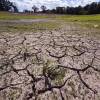The U.S. Environmental Protection Agency’s New England office has taken a first-in-the-nation step toward reducing stormwater runoff in urban rivers. The regional office is setting up a new regulatory regime that will focus on private landowners with an acre or more of impervious surfaces — like parking lots, roofs and driveways — and will hold them responsible for the polluting stormwater that runs into three Boston-area waterways: the Charles, Neponset and Mystic Rivers. It’s the first time such regulations will be used in a major urban area anywhere in the country.
The pollution found in stormwater runoff plagues rivers around the country, but the EPA says polluted runoff is worse in urban and suburban areas. That’s where there are generally more pollutants for stormwater to pick up, and more impervious surfaces, like concrete and asphalt, that prevent the stormwater from soaking into the ground before it reaches a waterway.
“Every time it rains or snows, all that water — and this is true in every community in America — all that water runs off ... carrying everything that's on those surfaces,” said Emily Norton, the executive director of the Charles River Watershed Association. “Gasoline, oil, fertilizer, pet waste, salt, dirt, trash, you name it, straight into the river.”
In the Charles River, pollution from stormwater causes periodic fish die-offs and toxic algae blooms, which are fed by the phosphorus and nitrogen in runoff, said David Cash, the region’s EPA administrator.
“And these are problems that climate change is exacerbating tremendously,” Cash said. “We have increased storm events, higher precipitation in smaller amounts of time that causes these runoff events. We've got warmer summer days, which ends up with these algal blooms. ... And of course, they hit the communities that have environmental justice concerns first and worst.”
The new regulations could take years to codify and implement.
The Charles River Watershed Association said landowners with large areas of impervious surfaces, which includes big box stores, strip malls, and large industrial and institutional properties, account for about 20% of the land area that drains into that river, but the EPA says those properties account for up to 70% of the stormwater pollution that finds its way into the Charles.
Tamara Small, the CEO of NAIOP Massachusetts, the Commercial Real Estate Development Association, said her organization has been in conversations with the EPA on regulating stormwater runoff from private properties for over a decade. She said the private sector is cautious about how much the new regulations could cost.
Small said that an EPA Charles River pilot program to stem stormwater pollution in 2010 indicated at the time that the costs to private landowners in some three dozen communities along the river “was really going to be in the billions of dollars for compliance.”
Since then, Small said, the EPA has included more techniques of reducing stormwater runoff that could be more affordable for developers and property owners.
“Sometimes some really simple steps, like cleaning up leaf debris, can make a big difference,” Small said. “Rather than ripping up a parking lot and installing very costly stormwater systems, you can do some simple things that actually make a big difference with not a significant cost.”
According to both Norton and Cash, stormwater pollution is one of the last remaining major pollution problems to fix in local waters.
In 1988, the Boston Harbor Cleanup Lawsuit led to the first great reduction of pollution in the area’s watersheds by addressing the most urgent problem at the time: 1.7 billion gallons a year of sewer overflow discharges, including 150 million gallons per year of untreated sewage. By 2005, both those sources of pollution had been reduced by 90% in the lower Charles.
Cash said that the EPA has aggressive targets to reduce pollutants from stormwater runoff released into the Charles, Neponset and Mystic Rivers, and that regulating the runoff coming from large landowners is the best way to get the rivers to where they need to be.
“When we hit those targets, people will be able to enjoy the river,” Cash said. “I, for one, will go swimming in those rivers and I will invite community members, families to go swimming in those rivers, too. That's our goal. We want to make our rivers swimmable and fishable. ... That's the future that we need to be in, and that's where this new program is going to take us.”








